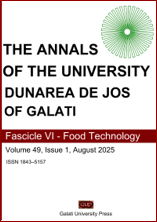Antifungal potential of some plants on mycelial growth and Aflatoxin B1 biosynthesis of Aspergillus flavus
Abstract
In this study, antifungal activities of 15 plant species were examined in vitro against toxicogenic Aspergillus flavus. Among the tested plants, Origanum vulgare powders showed the highest antifungal activity. O. vulgare powders inhibited mycelial growth of A. flavus by 100%. Our study continued with O. vulgare powders, which showed the highest in vitro antifungal activity against A. flavus. Minimum inhibitory concentration (MIC) value of O. vulgare aqueous extract was 250 µg/mL. The antifungal activity of O. vulgare on A. flavus mycelium growth in artificially infected sunflower, wheat, maize and rice grains was tested in vivo. These grains, artificially infected with A. flavus, were stored in test tubes containing O. vulgare extracts (2, 4, 8, 16 and 32 mg/mL) for 5 days (25oC). After the storage period, these grains were transferred to Petri dishes containing Potato Dextrose Agar (PDA). After the 5th day of incubation (25oC), O. vulgare extracts were unable to completely inhibit the mycelial growth of A. flavus. However, inhibition of mycelial growth of A. flavus was observed. Especially in infected sunflower grains, the inhibition of mycelial growth of A. flavus was significant (p<0.05) at all tested concentrations of O. vulgare extracts. Scanning electron microscope (SEM) analysis determined that aqueous extracts of O. vulgare made lysis, collapse, flattening and degenerative changes of cells with wrinkled cell surfaces on hyphal morphology. HPLC results showed that 8 mg/mL aqueous extract of O. vulgare inhibited A. flavus production of aflatoxin B1 by 100%. We can emphasize that aqueous extracts of O. vulgare have great potential against A. flavus, a producer of aflatoxin B1.


